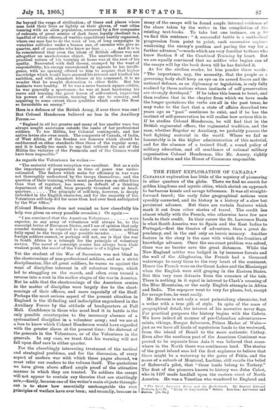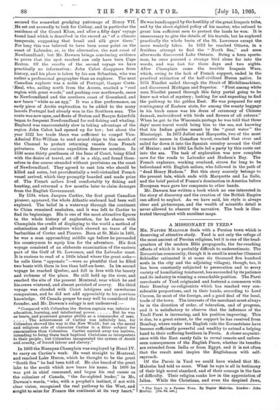CANADIAN exploration has little of the mystery of pioneering in
other quarters of the globe. There we find no search for golden kingdoms and mystic cities, which shrink on approach to barbarous kraals and savage tribesmen. It was all straight- forward travel ; the early false geographical notions were speedily corrected, and its history is a history of a slow but persistent advance. But there are certain features which mark it out from other stories of travel. The credit lies almost wholly with the French, who otherwise have few new lands to their credit. In their career the St. Lawrence Basin is what South America was to Spain and the East Indies to Portugal,—first the theatre of adventure, then a great de- pendency, and in the end only an heroic memory. Another feature in the story is the ease with which the frontiers of knowledge advance. Once the sea-coast problem was solved, there was no barrier save the great distances. While the New England settler was hedged in by immense forests and the wall of the Alleghanies, the French had a thousand waterways to carry them to the very heart of the continent. Hence the French were on the Great Lakes and the Mississippi when the English were still groping in the Eastern States. But this very ease detracts from the romance of the tale. There is nothing in it equal in interest to Clark's crossing of the Blue Mountains, or the early English attempts in Africa and India. The voyageur went to very far places, but, except for savage foes, he went easily.
Mr. Dawson is not only a most painstaking chronicler, but a writer with a true gift of style. In spite of the mass of geographical detail, the interest of his narrative never flags. For practical purposes the history begins with the Cabots. We have indeed all manner of pre-Columban adventurers— saints, vikings, Basque fishermen, Prince Madoc of Wales— just as we have all kinds of mysterious lands to the westward, from the island of Brasil to the more authentic Cathay. Even after the southern part of the American Continent was proved to be separate from Asia it was believed that some- where in the North there was continuous land. The stories of the great inland seas led the first explorers to believe that there might be a waterway to the gates of Pekin, and the name of a suburb of Montreal, Lachine, still recalls the belief of Robervars pilot, that "these lands belong to Tartary." The first of the pioneers known: to history was John Cabot, who in 1497 made landfall upon the eastern coast of North America. He was a Venetian who wandered to England and • The Saint Laurance Basin and its Borderlands. By Samuel Edward Dawson, Litt.D. "Story or Exploration" Series. London: Lawrence and Sullen. [7s. 6d.]
secured the somewhat grudging patronage of Henry VII. He set out avowedly to look for Cathay, and in particular the residence of the Grand Khan, and after a fifty days' voyage found land which is described in the record as "of a climate ' temperate, suggesting that brasil and silk grow there." For long this was believed to have been some point on the coast of Labrador, or, in the alternative, the east coast of Newfoundland ; but Mr. Dawson brings convincing evidence to prove that the spot reached can only have been Cape Breton. Of the results of the second voyage we have practically no information : John Cabot disappears from history, and his place is taken by his son Sebastian, who was rather a professional geographer than an explorer. The next Canadian explorer was a noble of Portugal, Gaspar Corte- Real, who, sailing north from the Azores, reached a "cool region with great woods," and pushing ever northwards, came to Newfoundland and the southern coast of Greenland, and saw bears "white as an egg." It was a fine performance, an early piece of Arctic exploration to be added to the many laurels Portugal had already won in the Southern seas. The route was now open, and fleets of Breton and Basque fisherfolk began to frequent Newfoundland for cod-fishing and whaling. England was unaccountably slow in taking advantage of the region John Cabot had opened up for her ; but about the year 1522 her trade there was sufficient to compel Vice- Admiral Fitz-William to send armed ships to the mouth of the Channel to protect returning vessels from French
privateers. One curious expedition deserves mention. In 1536 some thirty gentlemen of the Inns of Court, being filled -with the desire of travel, set off in a ship, and found them-
selves in due course stranded without provisions on the coast of Newfoundland. They agreed to cast lots who should be killed and eaten, but providentially a well-victualled French vessel arrived, which they promptly boarded and made prize of. The French sailors lived comfortably by fishing and hunting, and returned a few months later to claim damages from the English Government.
By 1534, when Jacques Cartier, the first great Canadian pioneer, appeared, the whole Atlantic seaboard had been well explored. The belief in a waterway through the continent to China remained unshaken, and it was left to Cartier to find its beginnings. His is one of the most attractive figures in the whole history of exploration, for he shares with Champlain the credit of displaying to the world a method of
colonisation and adventure which showed no trace of the barbarities of Cortez and Pizarro. Born at St. Malo in 1491, he was a man approaching middle age before he persuaded his countrymen to equip him for the adventure. His first voyage consisted of an elaborate examination of the eastern part of the Gulf of St. Lawrence, and the Labrador coast. It is curious to read of a little island where the great auks—
he calls them " apponatz "—were so plentiful that be filled two boats with them in less than half-an-hour. In hie second voyage he reached Quebec, and fell in love with the beauty and richness of the place. He still held up the river, and reached the site of the present Montreal, near which he and his crews wintered, and almost perished of scurvy. His third voyage was clouded with Court intrigues and unwelcome companions, and he did not add appreciably to his previous knowledge. Of Canada proper he may well be considered the founder, and Mr. Dawson's eulogy is not undeserved :—
" Compared with Columbus the Breton captain was inferior in
education, learning, and intellectual power But he was as brave, and possessed greater ability as a commander of men.
The achievement of Cartier was infinitely less, for Columbus showed the way to the New World; but on the moral and religious side of character Cartier is a fitter subject for canonisation than Columbus. Cartier carried away ten natives, intending to bring them back baptised Christians as interpreters to their people ; but Columbus inaugurated the system of deceit and cruelty, of forced labour and slavery."
In 1603 the Biacayan Champlain was employed by Henri IV. to carry on Cartier's work. He went straight to Montreal, and reached Lake Huron, which he thought to be the great "South Sea" he had been told of. He also heard of the great lake to the south which now bears his name. In 1608 he was put in chief command, and began his real career as the coloniser of Canada, "the far-sighted leader," in Mr.
Dawson's words, "who, with a prophet's instinct, if not with clear vision, recognised the real pathway to the West, and sought to seize for France the continent at its very heart."
He was handicapped by the hostility of the great Iroquois tribe, and by the short-sighted policy of his master, who refused to grunt him sufficient men to protect the lands he won. It is unnecessary to give the details of his travels, but he explored practically the whole basin of the St. Lawrence except the more westerly lakes. In 1613 he reached Ottawa, in a fruitless attempt to find the "North Sea," and soon afterwards discovered Lake Ontario. Being a keen sports- man, be once pursued a strange bird alone far into the woods, and was lost for three days and two nights. After Champlain came the terrible Iroquois Wars, which, owing to the lack of French support, ended in the practical eitinction of the half-civilised Huron native. In 1634 Nicollet sailed through the Strait of Michilimackinac, and discovered Michigan and Superior. "First among white men Nicollet passed through this fairy portal going to he knew not what of mystery ; looking for and expecting to find the pathway to the golden East. He was prepared for any contingency of Eastern state, for among the scanty baggage in his birch canoe was his dress of ceremony of Chinese damask, embroidered with birds and flowers of all colours." When he got to the Wisconsin portage he was told that three days' more travel would bring him to the sea, not knowing that his Indian guides meant by the "great water" the Mississippi. In 1673 Jolliet and Marquette, two of the most romantic names in Canadian travel, reached that river and sailed far down it into the Spanish country around the Gulf of Mexico ; and in 1682 La Salle led a party by this route out into the sea. The task of exploration was now complete save for the roads to Labrador and Hudson's Bay. The French explorers, working overland, strove for long to be beforehand with English sailors, who followed in the path of "dead Henry Hudson." But this story scarcely belongs to the present tale, which ends with Marquette and La Salle, and the brief period of France's domination in America before European wars gave her conquests to other hands.
Mr. Dawson has written a book which no one interested in the story of discovery and the creation of the British Empire can afford to neglect. As we have said, his style is always clear and picturesque, and the wealth of scientific detail is never allowed to obscure the narrative. The book is illus- trated throughout with excellent maps.







































 Previous page
Previous page